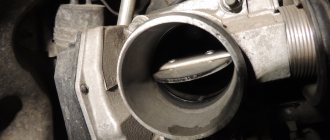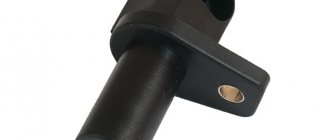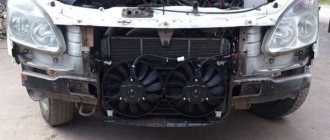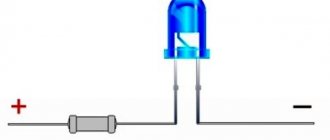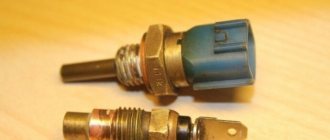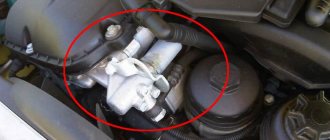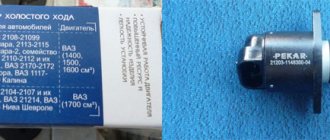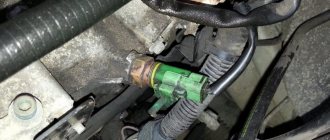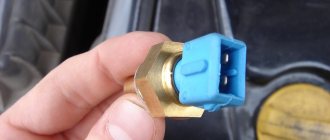Checking the coolant temperature sensor (CTS) is a work aimed at determining the performance of the unit and its ability to respond to changes in temperature conditions.
To complete the work, you can go in two ways: immediately dismantle the device or first carry out a check without removal.
When choosing the first option, you will need a regular wrench of the required size (usually “19”), but on some foreign cars - a 20, 21 or 22 socket.
First make sure that the DTOZh receives a voltage of 5V (from 5 to 12 on some models). If it fits, you can proceed with the rest of the test.
Below we will consider in detail all the diagnostic methods, the causes of sensor failure, features of its location and other features using the example of VAZ cars with 8 and 16 valves, Kalina, Gazelle, 2115, 2114, Renault Logan, Lada Priora and Chevrolet Niva. The methods described below are also suitable for most other brands of cars.
Design and principle of operation
The DTOZh temperature sensor is a resistor (thermistor) that reacts to the temperature of the antifreeze in the engine cooling system. Information about the resistance of this element is transmitted to the ECU, which decides to change the settings in the engine operation.
The information obtained is used by the ECU to determine the steps of the idle speed regulator to optimally adjust the required volume of the fuel mixture.
The peculiarity of DTOZH is that in the cold its resistance increases, and when heated, on the contrary, it decreases.
So, when reaching 130 degrees Celsius, the resistance parameter is 70 Ohms, and at minus 40 degrees - 100.7 kOhms.
The thermistor is controlled by applying +5 V voltage to it from the controller.
The potential passes through a classical resistor with constant resistance (R).
The antifreeze heating level is calculated based on the voltage drop across the DTOZh with variable R (Ohm). In this case, the drop will be large on a cold engine, and low on a warm engine.
Where to look for DVT in a car?
You can verify whether the sensor is faulty or serviceable by simply checking it. But first you should know something about the location of the DTOZH. It is better to find out where the coolant temperature sensor is located in a particular car from its operating manual. The fact is that in different models it may have a different location. Most often, the DTOZH is installed on the inlet pipe of the cylinder head cooling jacket or on the thermostat housing.
It is important not to confuse the coolant temperature sensor with the coolant temperature gauge sensor (TEG). The latter also serves to determine the coolant temperature, but its data is used solely to inform the driver.
Where is
To check the DTOZH, you need to know its location. Please note that the location of the sensor may vary depending on the make/model of the machine.
Most often, the thermistor is mounted between the cylinder head and the thermostat or on the coolant outlet pipe.
But on some cars it is installed on the radiator pipe.
Externally, the device looks like a small element with a thread, with which the DTOZH is screwed into a special hole. In this case, the regulating element itself is located in the antifreeze and controls its temperature.
In certain cars, for example, the BMW E39, there may be two DTOZH. One controls the heating of the antifreeze and is installed at the outlet of the engine, and the second is located behind the radiator. To remove you will need a 22 key.
This type of installation allows you to control the temperature in different areas and thereby take action faster.
Note that two sensors are installed on powerful / expensive cars, where the temperature parameter is of key importance.
In this case, the control unit must have appropriate programs. For more information, please refer to your vehicle's manual.
Functionally, the sensor is very reliable and breaks down in rare cases. Most often it shows false information. Sometimes other damage is possible, for example, chafing of wires or poor contact quality.
As for the features of the location of the DTOZH on different models, we will dwell on this issue below.
How to replace?
The process of replacing the sensor will not cause any difficulties even for a person who has never repaired a car, especially if the device has already been dismantled for inspection. The only thing you need to do is purchase a new DTOZH. The price of coolant temperature sensors, depending on the brand of car, can vary between 300-800 rubles.
Having purchased a DTOZH, all you need to do is first check it in the manner described above (to be more confident in its functionality), and then screw it in place of the old one and connect the appropriate connector. After this, add coolant and also connect the ground wire to the battery. Next, we start the engine, warm it up and observe the operation of the cooling system: whether the error on the dashboard has disappeared, whether the radiator fan turns on in a timely manner, whether the engine is running smoothly, etc.
Symptoms of a problem
To take measures to control the coolant temperature sensor, it is necessary to identify problems in this unit in time.
But it is worth considering that the signs discussed below may indicate other malfunctions of the power unit.
This is why additional diagnostics may be required to obtain an accurate result.
It is also important to understand what part the DTOZH takes in the operation of the engine:
- Informs the driver in real time about the coolant temperature.
- When the engine reaches a threshold temperature value, the ECU, having received information from the coolant sensor, turns on the forced cooling fan, as a rule, this is about 100 0C.
- Participates in the process of increasing idle speed by enriching the fuel-air mixture on a cold engine.
- When the car is moving, the ECU generates general information about the operation of all systems based on the data received from the sensors and, based on this data, forms the correct fuel-air mixture. The coolant temperature sensor also takes part in this process.
Primary symptoms of failure:
- The Check Engine light on the dashboard comes on. To obtain more accurate information, it is better to scan the ECU and look for errors, for example, through an ELM327 auto scanner connected to a smartphone. See error codes below.
- The engine starts and immediately stalls.
- Malfunction of the fan in the radiator. The malfunction may manifest itself as a refusal to turn on when it heats up or operation even after the motor has cooled down. When the DTOZ is turned off, the electronic control unit of the machine perceives the problem as a break and turns on the fan.
- The appearance of dark or gray-black smoke from the exhaust pipe.
- Increased "gluttony" of the car. This is due to the fact that incorrect information is supplied to the ECU. Accordingly, the “brains” of the machine cannot determine the volume of displacement required to maintain optimal temperature conditions.
- Antifreeze leaking from under the DTOZh housing. This problem can be determined by visual inspection.
- A hot engine stalls. The problem may occur when the maximum temperature is reached. In this case, the type of coolant filled does not matter.
- The power unit heating indicator on the dashboard does not work.
- Engine malfunctions. The problem may manifest itself as stopping at low speeds, difficulties starting in winter, hesitation when operating at idle, etc.
- The coolant boils, but the instrument panel displays the temperature within normal limits.
- Increased engine heating time, etc.
The problems discussed above can occur one at a time or in combination, but in most cases they indicate a malfunction of the power unit. However, the antifreeze temperature sensor is not always the main cause of the malfunction.
DTOZH: malfunctions
Malfunctions of the coolant temperature sensor include:
- violation of the calibration of the working element (thermistor), as a result of which its resistance does not correspond to the specified temperature parameters;
- shorting the positive contact to ground;
- violation of the tightness of the sensor housing;
- lack of electrical contact on the connector.
As you can see, there are not many faults with DTOZH. In the first case, the sensor simply begins to lie, misleading the electronic unit. The latter, using unreliable information, will be forced to make wrong decisions. This results in difficulty starting the engine, excessive fuel consumption, and untimely activation of the radiator fan.
A short circuit in the sensor occurs when its housing is deformed or destroyed. This phenomenon is easily determined by the controller, about which it sends a corresponding signal to the instrument panel.
Violation of the seal of the housing most often also occurs due to mechanical damage to the sensor, less often due to long-term operation.
If there is no contact on the DTOZH connectors, the controller usually keeps the engine running in emergency mode, and the radiator fan runs in constant mode, just in case.
The first three faults cannot be eliminated. Here, only replacing the DTOZH can correct the situation. In the latter case, contact can be restored, which is not difficult. After this, you must recheck the functionality of the cooling system.
How to check without removing it from the car
If you suspect a faulty DTOZH, it is not necessary to remove it from the car. All manipulations can be done without dismantling using a tester or diagnostic device. Let's consider each of the methods in more detail.
Pre-check
To check the temperature meter, start the car and let the engine warm up at idle to 90 - 95 0C.
Disconnect the connector from the sensor and notice how the arrow on the instrument panel behaves:
- if the arrow remains in place, then you need to check the meter itself or the electrical circuit going to the device (more on this later);
- if the arrow goes down, then check the fuse. If it is intact, and when the contact is shorted to ground, the arrow jumps, then the sensor is faulty.
Multimeter
The simplest method to check the coolant temperature sensor is to use a tester.
First, we check the voltage; for this, set the multimeter to the “Measure constant voltage up to 20V” mode.
- Disconnect the connector from the meter.
- Turn on the ignition.
- Connect the positive wire of the device to the “+” connector, and short the second contact of the tester to the motor. The device should show between 4.8 and 5.2 V.
When working on a hot engine, be careful not to touch the metal surface, so as not to burn yourself and damage the measuring device.
The algorithm of actions is as follows:
- Discard the contacts from the sensor.
- Set the resistance measurement mode on the multimeter.
- Measure the parameter between the terminals.
- Compare them with the tabular data that can be found in your vehicle's repair and maintenance manual.
On some car models, it is very difficult to get to the sensor connectors and you will have to remove it.
To minimize antifreeze losses, unscrew the expansion tank cap to relieve pressure in the system. Then tighten the plug again.
Exact resistance specifications may vary depending on model.
As an example, we give several resistance parameters for a VAZ 2110 car.
Table 1.
| Temperature 0C | Ohm resistance |
| +100 | 177 |
| +80 | 332 |
| +60 | 677 |
| +40 | 1459 |
| +20 | 3520 |
| +10 | 5670 |
| +5 | 7280 |
If the DTOZH produces erroneous information, it may need to be removed for a more detailed check, and subsequently replaced.
Diagnostic tool
If an engine error appears on the dashboard, it is worth checking the ECU for errors related to the temperature sensor.
The most convenient option is to use an ODB2 scanner. To avoid high costs, you can use a simple model of Scan Tool Pro Black Edition or ELM327, which we wrote about above.
The general algorithm of actions is as follows:
- Inspect the DTOZH for damage to the wires or the appearance of rust.
- Connect the device and read the errors (see the link above for how to do this).
- Codes P0115, P0117. P0116 or P0118 indicate the presence of malfunctions in the functioning of the sensor.
The capabilities of the model discussed above allow you to look at the operation of the sensor online, as well as look at the functioning of other components: gearbox, transmission, ESP, ABS and others.
The device works with all diagnostic software and works without loss of communication. Bluetooth and Wi-Fi are used for communication.
How to check DTOZH?
To check the sensor you will need:
- car tester (multimeter);
- electric kettle or other devices for heating water;
- thermometer for liquid.
Checking the sensor consists of determining the correct calibration of the working element of the DTOZH. What does it mean? This means that when conducting a test, it is necessary to determine how correctly the thermistor resistance changes depending on temperature.
To begin with, the sensor contacts are connected to the multimeter probes, observing the polarity. The device is turned on in ohmmeter mode. After this, the DTOZH together with the thermometer is immersed in cold water and their readings are read. Next, the water is heated while continuing to take measurements.
Below is a table for calibrating coolant temperature sensors.
| Temperature, 0C | Working element resistance, Ohm |
| 0 | 7300-7500 |
| +20 | 2600-2800 |
| +40 | 1000-1200 |
| +60 | 500-600 |
| +80 | 300-350 |
| +100 | 160-180 |
If the resistance values of the DTOZh working element differ from those given in the table, the sensor is faulty.
Checking the removed DTOZH
For a more accurate check, it is recommended to remove the device from the vehicle. To do this, you need to let the engine cool, and then drain the coolant from the system.
To remove it, you only need a key “19” (20, 21, 22), with which you can unscrew the sensor and remove it together with the ring.
At the same stage, it is worth assessing the condition of the device itself, its threads, cleaning and lubricating it.
The same operations can be done with respect to the sensor itself. After dismantling is completed, you can proceed directly to work.
Checking with a thermometer
After dismantling, you can check with a thermometer. This option provides the most accurate information, so it is recommended for most cases.
The algorithm of actions is as follows:
- Prepare a vessel and pour water into it.
- Use a boiler to heat water.
- Prepare your multimeter for measurements.
- Immerse the sensor element in the liquid.
- Provide the ability to connect a multimeter to the contacts.
- Place a thermometer in the water to monitor the temperature. It is better to use the electronic version, which provides greater accuracy.
- Heat the water and take measurements for different temperatures, for example, from +5 degrees Celsius and above in steps of “5”.
- Fill out the table containing the resistance parameters in relation to the set temperature.
- Check with the information provided in the vehicle manual.
Of course, inaccuracies may occur during the measurement process. The error depends on several factors: operating conditions and the characteristics of a particular DTOZH. In particular, even in devices of the same model, the resistance parameter may differ.
Without thermometer
If desired, checks can be made without using a water temperature meter.
In this method, you can act according to the principle discussed above, but with minor restrictions.
The general algorithm is:
- Boil the water.
- Install the DTOZh sensitive element into it.
- Measure the resistance at the terminals.
At a temperature of about 100 degrees Celsius, the resistance should be about 177 ohms. But here you need to take into account possible errors.
In particular, at the time of measurements, the temperature may change downward.
The disadvantage of the method is that the test is performed only at one temperature point.
Checking the coolant temperature sensor
First, you need to figure out where the coolant temperature sensor is located. Simply put, a DTOZH is a compact device in a housing that must be in direct contact with the coolant to measure its temperature.
The sensor has a thread. Thanks to this thread, it is screwed into the cylinder head, can stand on the upper radiator hose, and in some cases the installation location is the thermostat housing.
Please note that since the sensor must be in contact with the coolant, low levels of antifreeze or antifreeze in the system may cause the readings to be inaccurate. It turns out that before checking the sensor, you should check the coolant level in the system.
Let’s also add that there are car models that have two DTOZH at once (one engine temperature sensor is placed at the fluid outlet from the engine, while the other is at the fluid outlet from the radiator of the cooling system).
In this case, you need to take into account that only one sensor can fail, since it is rare for two to fail at once. One way or another, having decided where the DTOZh sensor is located, its installation location and the total number of such sensors, you can move on to how to check the coolant temperature sensor.
First you need to make sure that the wiring to the sensor is working properly. In order for the DTOZH to work normally, a constant voltage of 5 Volts is supplied to the sensor. To check the wiring, you need to disconnect the wires from the sensor, then start the engine and use a multimeter to check the voltage supplied to the sensor.
- If the voltage is normal (5 Volts), then you can proceed to checking the sensor. First, the sensor is unscrewed with a key and inspected for mechanical damage. Next, you should check the resistance and overall performance.
To do this, you will need a multimeter, an electronic thermometer, an electric heater or a kettle for heating water. After removing the sensor from the car, checking the DTOZH can be done in two ways.
To test the sensor using heat:
- First, the thermometer is placed in a kettle with cold water;
- then a multimeter is connected to the sensor, the resistance measurement mode is turned on;
- now the sensor itself is placed in the kettle;
Next, the resistance readings are recorded. First, measurements are taken for cold water, then you need to start heating the water. At the same time, resistance readings are recorded when heated to 10, 15, 20 degrees Celsius and higher.
Next, the obtained readings need to be compared with the optimal ones, which can be found in the technical literature, in special tables or on auto forums. If significant differences from normal values are noticeable, then the coolant temperature sensor has failed and needs to be replaced.
The second method of checking the DTOZH is quick and simple, however, less accurate. A thermometer is not needed for diagnosis. Considering that water boils at 100 degrees, that is, the temperature does not rise higher, this mark can be used as a control point.
We also recommend reading the article about what a thermostat is in an engine cooling system. From this article you will learn about the purpose, design, principles of operation, as well as problems and methods for checking the thermostat of the engine cooling system.
All that remains is to place the coolant temperature sensor in boiling water and measure the resistance of the sensor with a multimeter tester. The norm is considered to be when, when the liquid is heated to 100 degrees Celsius, the sensor shows an average resistance of 175-178 Ohms.
However, it is important to take into account that during boiling the temperature may not be 100, but 96-98 degrees. In other words, there is a slight error. Taking this correction into account, the sensor resistance readings at 195-210 Ohms can be considered normal.
In any case, comparing the obtained data with the DTOZh resistance table allows you to clearly determine if there are problems with the sensor and the performance of the thermistor of the coolant temperature sensor.
Features of checking for VAZ 2110
The “tens” configuration includes two types of engines – 8 and 16 valves. But the features of the DTOZH, location and replacement are identical.
On these VAZ 2110 you can use the Lusar LS 0101 temperature sensor. The car has two coolant temperature meters installed, one near the thermostat and it interacts with the computer, the second on the radiator and transmits data to the instrument panel.
The procedure for checking is the same; resistances at different temperatures are shown in Table 1.
Useful tips
- Before you start replacing a non-working coolant temperature sensor, make sure that this is the cause.
- Buy and install DTOZh only of the modification provided by the vehicle manufacturer.
- Systematically check the condition of the cooling system and the functionality of its individual elements.
- Pay attention to the coolant temperature values. If an error appears on the instrument panel related to the performance of the cooling system, immediately take measures to eliminate the causes of the malfunction.
- Never fill the engine with poor quality coolant or water. Do not mix antifreeze and antifreeze in the same system.
VAZ 2114, VAZ 2115
On these cars, GM 2112-3851010-01 can be used as a DTOZH. The location of the device is between the cylinder head and the thermostat.
To check, it is recommended to dismantle the element (open-end wrench size 19). To do this, you need to wait until the engine cools down, reset the negative voltage on the battery and drain the antifreeze.
After this, you need to dismantle the device and check it by heating the liquid, a thermometer and a multimeter.
The following parameters must be present.
Table 2.
| Temperature, 0C | Resistance, Ohm | Voltage, V |
| +30 | 1350-1880 | 8 |
| +50 | 585-820 | 7,6 |
| +70 | 280-390 | 6,85 |
| +90 | 155-196 | 5,6 |
| +110 | 87-109 | 4,7 |
If there is a discrepancy in the readings, the device must be replaced.
Gazelle (engines ZMZ 406, 405, 409)
Installation location - on the power unit in the area of the thermostat or on the body of the latter.
To remove it, it is necessary to partially drain the coolant from the engine, disconnect the spring clamp of the harness block and discard the block from the sensor.
Next, using a key set to “19” you need to loosen the broach and unscrew the device.
When choosing a device, you need to focus on the engine and ECU.
406 engine and ECU Mikas 7.1, 5.4, SOATE, VS5.6
In such cases, a DTOZH is used, operating at a voltage of 5 to 12 Volts through a resistance of 9.1 kOhm.
Several types of devices are suitable for replacement: Kaluga 19.3828, Luzar LS 0306, Rikor 40.5226 or Autotrade 42.3828.
When checking, you will also need water with a boiler and variable temperature, as well as a multimeter.
To work, you need to assemble a circuit and apply 1 to 1.5 mA to it. In this case, it is necessary to measure not resistance, but voltage.
When checking, the following parameters must be present:
- -60 0С - 2.13 V;
- -40 0C - 2.33 V;
- -20 0C - 2.53 V;
- 0 0C - 2.73 V;
- +40 0С - 3.13 V;
- +80 0С - 3.53 V;
- 105 0C - 3.83 V;
- 125 0C - 3.98 V.
When the engine is running, the voltage will be 5 V.
Engine 405, 409, UMZ 4216E3, 4213 control unit Mikas 11 / 10.3, VS8, SOATE
DTOZH with catalog numbers 234.3828, 40.5215 or 421.3828 are used here.
Unlike the method discussed above, here it is necessary to measure resistance.
In this case, the dependence should be as follows:
- 128 0C - 80.8 Ohm;
- 100 0С - 177 Ohm;
- 80 0С - 332 Ohm;
- 60 0С - 667 Ohm;
- 40 0С - 1459 Ohm;
- 20 0С - 3520 Ohm;
- 0 0С - 9420 Ohm;
- -20 0С - 28680 Ohm;
- -40 0С - 100707 Ohm.
In case of significant deviations from these parameters, the device must be replaced.
Niva Chevrolet
For installation, you can use DTOZH 2112-3851010 Kaluga (23.3828). It is difficult to visually determine the location of the device, because it is covered by other parts.
After removing them, you can see that the device is located in the upper part of the thermostat in the hole in the front pipe of the water jacket (the one that goes into the cylinder block). After unscrewing it (snap on 19), antifreeze does not flow.
The check is carried out according to the same schemes as discussed above. In this case, you need to have before your eyes a table with the parameters of temperature and resistance of the DTOZH.
Table 3.
| Temperature, 0C | Resistance, Ohm |
| +100 | 177 |
| +90 | 241 |
| +80 | 332 |
| +70 | 467 |
| +60 | 667 |
| +50 | 973 |
| +45 | 1188 |
| +40 | 1459 |
| +35 | 1802 |
| +30 | 2238 |
| +25 | 2796 |
| +20 | 3520 |
| +15 | 4450 |
| +10 | 5670 |
| +5 | 7280 |
| 0 | 9420 |
| -4 | 12300 |
| -10 | 16180 |
| -15 | 21450 |
| -20 | 28680 |
| -30 | 52700 |
| -40 | 100700 |
Also on the Chevrolet Niva, in the area of the 4th spark plug, there is a DUTOZH (coolant temperature indicating sensor), which displays data on the instrument panel; it does not transmit information to the ECU and does not affect the operation of the engine.
But it can provide incorrect data to the instrument panel and mislead the driver.
You can unscrew it without draining the coolant, but before doing this, relieve the pressure in the system by unscrewing the cap of the expansion tank.
It is also checked by comparing the temperature with the readings of the multimeter.
See table below.
How does DTOZH work?
The coolant temperature sensor has two electrical contacts, one of which is a housing that is connected to ground, and the second is “+”, going to the electronic unit. The controller sends a voltage of 5 V to the DTOZH, which is transmitted to the working element using a conductive spring. The semiconductor thermistor itself has a negative temperature coefficient, and as the coolant in which it is placed heats up, its resistance begins to decrease. At the same time, tension also decreases. It is by its change that the electronic control unit calculates the temperature of the coolant in the system.
The temperature sensor, due to its simple design, fails quite rarely, but if this happens, it is replaced with a new device. A sensor malfunction is easy to determine. Its failure is most often accompanied by certain symptoms inherent only to a non-working DTOZH. Read on to find out what these signs are.
Kalina
The official version of the DTOZH for the VAZ 2112 is 2112-3851010. But you can use analogues, for example, ERA (33026), Luzar (LS 0112), Fenox (TSN 2211207).
The location of the sensor on a car with an 8- and 16-valve engine is near the thermostat. In this case, the device is slightly closed by the filter housing.
In this case, on the Lada Kalina 1 you will have to remove the air filter to access the temperature meter.
To unscrew, use a 19 key. There is no need to drain the antifreeze.
Check, as in the previous case, after removing the device with the key to “19”.
For temperature and resistance readings, see Table 3.
Checking the presence of operating voltage is carried out with a multimeter with the ignition on without removing the sensor between the block terminal “B” and ground (there are two terminals on the blocks “A” and “B”), standard readings are within 4.8-5.2 V.
Learning to check the sensor
What’s very good is that modern sensors provide the ability to check practically at home. It is only important for a motorist to have a multimeter on hand to measure voltages (although this indicator is not necessary to know for an initial assessment) and resistances, as well as any device for measuring temperature. You will also need a 19 mm wrench, an electric kettle and a container into which you will need to drain the coolant. Obviously, the latter is merging. It is enough to drain the liquid down to a level that is just below the position of the device. Next, you need to disconnect the wiring and use a 19 mm wrench to unscrew the sensor.
If a car has a sensor whose temperature coefficient is negative, then as the temperature rises, the voltage will drop. Initially it is equal to 4.00-4.50 Volts
.
You may ask why the voltage is less than the reference voltage. The sensor simply shunts this voltage, which is why the multimeter shows the same 4.00-4.50 Volts
.
As soon as the temperature increases by 10 ° C
, the voltage will drop by no more than 0.5 Volts.
If you don’t have a thermometer on hand, you can bring the temperature of the water in the electric kettle to 95-97 ° C
and measure the resistance - if it is approximately
177 Ohms
, everything is in order with the sensor.
If the coefficient is positive, the situation will be different. Already at 20 °C
the resistance will increase to a maximum of
297 Ohms
, and the voltage across the thermistor will be
0.6-0.8 Volts
.
And, say, at 80 °C
it will be
383-397 Ohms
and
1.0-1.2 Volts
, respectively.
However, more accurate values are given in tables of temperature dependences on ohmmeter readings. They are provided by the DTOZh manufacturers themselves. The guidelines are also set out in manuals from automakers. We advise you to study them if you want to operate your car as long and productively as possible.
Please also note that the electrical circuit may break or short to ground. Both indicate faulty conductive elements. In such cases, it is easier to replace the sensor, since it is not a repairable part.
Renault Logan
On Renault Logan you can use many types of DTOZH, for example, MEAT & DORIA 82187, JP GROUP 1293102400, Vernet WS2602 and others.
Originals:
- 12-RENAULT-7700101968 (triangle contacts) - installed on 8 valve engines until 2012.
- 12-RENAULT-226307034R – after 2012 (contacts in a row).
All of them are suitable for K4M and K7M motors, their locations vary.
So on the K4M (8 valves), the temperature meter is installed in the water distributor housing (in the cylinder block). He is alone, transmits information to the instrument panel and works in conjunction with the ECU.
On the K7M engine at the rear end of the cylinder head.
On the body of the block there are markings for the three terminals “A”, “B1” and “B2”. The operating voltage is measured, as in the case above, with the ignition on between terminal “B1” and ground. The norm is from 4.8 to 5.2 V.
If voltage is not supplied to the block, disconnect the wiring harness from the ECU and use a tester to check the wiring for an open circuit. We take measurements between “B1” and pin “13” of the ECU.
If the circuit is working, then the control unit has failed.
We switch the tester to the “Resistance measurement” mode and check for an open circuit in the “ground” circuit of the sensor between terminal “B2” and the body of the machine (engine).
Readings of less than 1 ohm indicate a healthy circuit. If the device shows infinity, then there is a break between terminals “73” of the ECU and “B2” of the block.
Next, if you don’t want to remove the coolant temperature sensor from the engine, use a tester to measure the resistance readings on a warm and cold engine between the sensor terminals “B1” and “B2”.
Normative data are shown in Table 4.
| Temperature, 0C | Resistance, Ohm |
| 120 | 105 |
| 110 | 135 |
| 90 | 240 (+/ — 30) |
| 80 | 335 (+/ — 35) |
| 50 | 810 |
| 25 | 2050 |
| 20 | 3500 (+/ — 500) |
| 4 | 7500 (+/ — 500) |
To further check the device, you can use one of the methods discussed above.
For greater reliability, it is advisable to dismantle the device; use a 21 head.
Location of temperature sensors
- One of them, DTOZH, is located on the cooling system pipe running from the block head to the thermostat. It sends signals to the computer's electronic control unit so that additional cooling (fan) is turned on in a timely manner. Don't look for it on the radiator; it was located there in previous models. Has two terminals. The DTOZh removed from the car looks like this:
Appearance of DTOZH
- The second sensor is called DTUOZH, it has one terminal and sends a signal to the dashboard in the cabin, where the driver sees the temperature of the coolant (not the engine, as many people mistakenly think). It is located, as can be seen from the first figure, on the engine block under the cooling system pipe. It may have a rubber cap that protects the terminal from moisture. DTUOZH looks like this:
Appearance of DTUOZH

